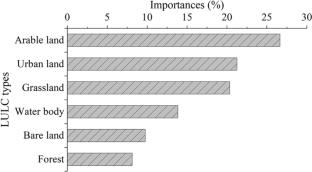Assessing impacts of land use/land cover patterns to shallow groundwater nitrate pollution in an agricultural-dominant area in northwest China using random forest
Abstract
Groundwater nitrate pollution is a serious environmental problem worldwide, which is demonstrated influenced by land use/land cover (LULC) patterns. The current study was carried out to investigate the effects of LULC patterns to the nitrate pollution of shallow groundwater in the north piedmont plain of the Qinling Mountain (NPQM) using an ensemble machine learning method named random forest. Groundwater nitrate data and existing LULC patterns datasets were utilized to conduct the study. LULC patterns were quantified using a curved streamline shaped contributing area stratagem, and subsequently used to create training and test datasets together with the groundwater nitrate data for construction of random forest model. The results of this study indicated arable and urban land were the main LULC types in the NPQM, and urbanization induced the occupation of arable land by urban land from 2015 to 2019. Shallow groundwater in the NPQM was polluted by nitrate in both 2015 and 2019, with area of groundwater nitrate concentration exceeding the standard limitation recommended by the WHO (50 mg/L as NO3—) reduced from 2762.2 km2 in 2015 to 2184.3 km2 in 2019, showing an alleviating trend. Arable and urban land were the main LULC types contributing to groundwater nitrate pollution. Nitrate accumulated in the soil from manure and chemical fertilizer was the main source for groundwater nitrate pollution in arable land, while manure and sewage were the main source in urban land. The study provides scientific insights for sustainable groundwater protection in the NPQM.


 求助内容:
求助内容: 应助结果提醒方式:
应助结果提醒方式:


